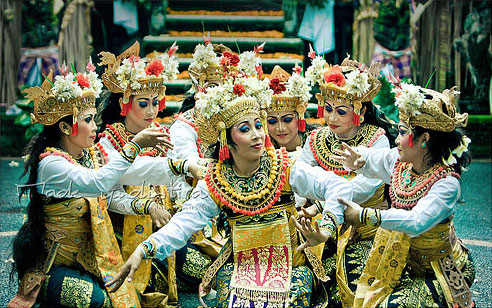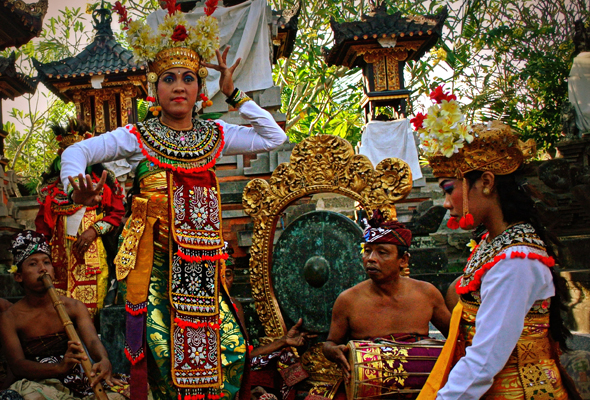
Beyond the beaches, the beautiful views, the temples and ceremonies, and other interesting tourist activities that Bali has to amaze its visitors there are also many dances that can be enjoyed. The elegance of movement the charm of the dancer and beautiful melodies are all a part of Balinese dance performances
Some dances that you might see at tourist sites are dances meant to entertain, but some dances are only performed for ceremonial purposes and these dances are more difficult to witness because they are only danced for certain religious ceremonies under certain conditions.
Balinese dance is classified into three categories: Wali dance, Bebali dance, and Bali-Balihan dance. Wali dances, such as Sanghyang dance, Baris dance, and Rejang dance, are dances that have a sacred function and are performed only at a certain time, location and situation considered holy to the community. These dances are performed in temples and their immediate surroundings and they are considered holy and sacred. Wali dance cannot be seen daily -and you cannot reserve a spot to see it and sometimes the dancer is in a trance while performing.

Bebali dance is a ceremonial dance that is performed in connection to a religious ceremony. An example is the Topeng Sidakarya dance, where the dancer has to fulfill certain spiritual terms and conditions to dance. Not anyone can perform this special dance; the Topeng Sidakarya dancer must be a medium priest who can recite several holy mantras; he is the one who will finish a certain step of a ceremony.
The Balih-Balihan dances are entertainment dances that you will see in many tourist locations. You can choose from a variety of performances of Balih-Balihan dances if you have a special occasion and wish to entertain your guests with Balinese dance. This category includes dance dramas like Gambuh, Arja, and Sendratari. New creations for this type of dance are taken from a variety of everyday themes such as Tari Tenun (Weaving Dance) and Tari Nelayan (Fisherman Dance), as well as wildlife: Kidang Kencana (Deer Dance).
Manuk Rawa (Swan), Cendrawasih (a special bird from Papua), and Oleg Tamulilingan (Bumble bee). Some dances are inspired by heroic stories such as Margapati, Yudapati, and Taruna Jaya, celebrating the glory of warriors ready to go to battle for their country. Interestingly, these dances are only performed by female dancers
Balinese dances are either sacred (with a function and a connection to a ceremonial occasion) or entertaining (performed solely to entertain an audience). There are two kinds of entertainment dances: the classics, which are basic old works, and the new creations, which are created by young choreographers, where the pattern of the dance is taken from the classic dance and combined with a new creation of dance movement. This is the kind of dance you will easily find in many tourist sites
A classic entertainment dance is the Gambuh Dance. Prof. Wayan Dibia, a researcher from ISI Denpasar (Indonesian Art Institute in Denpasar) explains that Gambuh is a Balinese dance-drama of the highest quality that is rich with dance movements that are the source of Bali’s other classical dance forms.
Gambuh dance was established during the 16th century. It is a form of total theater because the performance includes singing, dance, drama, literary arts and fine arts among others. This dance-drama is included in the classical sacred dance category because it is only performed during religious ceremonies. In the Kingdom era this dance was performed only for the King, Gambuh is an art performance with royal characteristics, which is why this dance was only performed in palaces during. the Kingdom era, where the King was respected throughout Bali as Dewa Raja, the God King, or the King considered a God. The Gambuh dance is performed during a ceremony inside the palace, and then the same dance iS performed during a temple ceremony outside palace. This means that the dance iS a Bebali dance: the a dance that completes a religious ceremony.
The story told in a Gambuh performance is from Panj or Malat, the Story of the Kingdom in East Java under the rule of Daha-Jenggala in the 13th century. In the 16th century, Gambuh was very popular. The performances used the Kawi language and Old Javanese, which are highly complex languages. Gambuh has an elaborate movement vocabulary that is difficult to understand and an extremely formal musical structure, which means that the dancer must understand the composition of the music and melody and transfer it to each movement of the dance.
In a newer development of Gambuh dance an additional performer is used as the translator of the Kawi and Old Javanese languages to Balinese so that the audience can understand. The translator is usually played by a Penasar. who also performs in other Topeng dances, and he must translate the words of the King. Without Penasar’s translation, the audience who has not studied the old languages would not understand the words spoken and sung in Gambuh dance performances.
This dance is one of the special dances Bali has to admire it, check temple festival schedules as well as social occasions at big palaces that require sacred and CISSIC dances in the ceremony. Check with your travel agent c at your hotel reception for schedules. Maybe you will be one of the lucky visitors who will be able to enjoy it. We hope you take much delight in the dance and the beauty of classic Bali.





